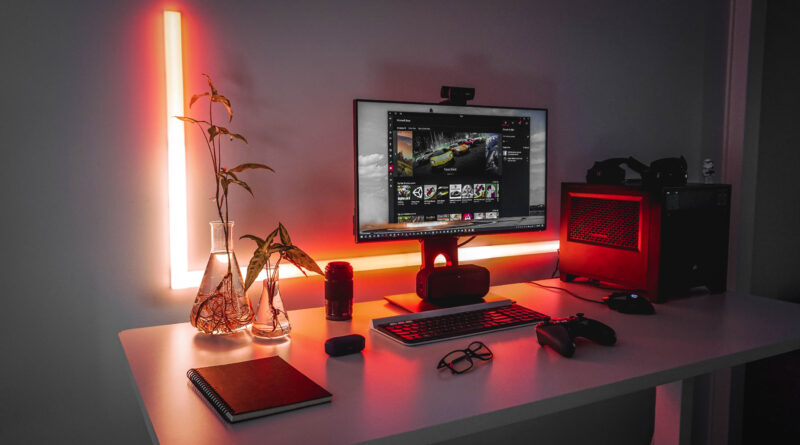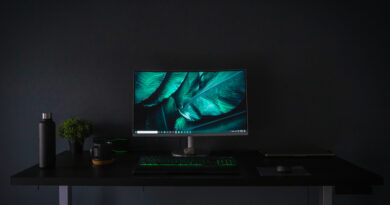Stationary Computer: Things to Check When Buying Computer
The case, the power supply, the fans, the memory volume, the processor, the motherboard, and more – everything that needs to be checked before buying a new desktop stationary computer or upgrading an existing one
Maybe the laptops and tablets are biting into their sales – but the desktops, the same boxes to which an external monitor is attached, have gone nowhere (literally).
They are still here, and still a not bad and relatively inexpensive option for those who want a stationary computer that will serve all members of the household or need more performance power for specific purposes – video editing, sound, resource-intensive software like Photoshop or drawing software – all of which are often trusted by desktops.
Today, buying a desktop stationary computer is very different from what we knew a few years ago. Peripherals that were once mandatory equipment like a graphics card have disappeared and merged with the central processor. Alongside the traditional magnetic hard drives, the moving partless movements have popped up, the SSDs, the operating systems have changed. In short, today’s desktop is not the desktop of the night.
So Why Pay Attention When Buying A New Desktop Stationery Computer?
* Please note: In stores that specialize in computers, you can request that they “assemble” a computer for you from a variety of parts that you choose. In other stores that only sell “ready-made” computers, you can check with the seller what the computer includes and whether it matches your needs

1: What Processor Does The Stationery Computer Have?
The processor, the “brain” of the computer, which now also contains the graphics processor, is the one that performs all the computational and graphics operations. Although AMD processors are available in the market, even newer series like the A-Series or E-Series, the company with the more significant presence is Intel.
Intel recently launched the new generation of their processors, the fourth generation of Core processors, dubbed Has well and known by its trade name, Core I 4th Generation.
The problem with Intel is that in every generation, the company changes the bracket and the number of “plugs” (legs) that the processor has. For customers, this is no minor headache because it means that. Must also replace the motherboard with the replacement of the processor. So what are we doing? Buy the newest. The current socket is called 1150.
Admittedly, the market is still flooded with previous-generation 3rd generation processors. They are sold relatively cheaply, but the difference is slight, so it is better to buy the more advanced generation of processors already if you are already buying a new one.
2: What Board Does The Computer Have?
Today, the motherboard in a stationary computer is the main component, the same board that all the other parts connect to. Still, nowadays, it also determines the number of available USB sockets we will have (or newer sockets like Lightning Bolt), the voice, and network ports. Unfortunately, on most tablets, options that are very common on mobiles, like Wi-Fi or Bluetooth, are pretty rare. You should read the board’s specifications and check in addition to the regular ports on it, how many expansion slots are in it and of what type (in case we want to add an expansion card), the number of sockets that the memories have (see also the next section) and how fast do they support
3: What Memory Does The Computer Have?
Today’s most common stationary computer memories are DDR3 at speeds of 1333 and 1600 MHz. But this is not the only important figure when buying memory. Another important figure is CL, short for CAS Latency. This figure represents the time difference between the request for information and a memory component until the information item is available at the exit of the memory. That is the gap between the request for information and the completion of its processing by the memory. In principle, a lower CL figure is better, but it also affects the price.
4: And What About The Amount Of Memory?
The more- the better in the latest edition operating systems like Windows 7 and Windows 8. In any case, we would not recommend installing less than four gigabytes of memory for a good performance today.
5: What Hard Drive Does The Computer Have?
Old-generation magnetic drives are increasingly being replaced by newer-type drives, solid-state drives, or SSDs, for short. These are volumes of memory components – like a disk on a key, but in large volumes. These components do not contain moving parts and are less prone to malfunctions. They are lighter and faster. Modern operating systems like Windows 8 make full use of them so that your computer can be ready for operation in eight seconds or less.
But, they have one drawback – they are still expensive, certainly compared to the traditional and cheap hard drives. Therefore, what is common today to do is to combine: put in the desktop computer also a small SSD drive, on which will sit the operating system and files that we frequently access, alongside a regular and chubby hard drive, which will store all our other information cheaply – photos, music, movies, etc.
It is common to purchase SSDs in volumes between 60 and 120 gigabytes. In comparison, the magnetic hard drive in the affordable book is a terabyte drive (1000 gigabytes, according to a decimal key). Please note that the warranty periods may vary depending on the series to which the movement belongs.
Pictured: Corsair SSD drive
6: What Package Do You Need?
Having already squandered our best money on the components inside the computer box, the box itself (which contains all the pieces of hardware) is always at the bottom of the list and often suffers from poor PR. Most people settle for a simple package or what they will sell you as a “fancy package,” which is a mistake. The case is also a component that deserves your attention and impacts computer performance.
There are some well-known names in the market (and yes, more expensive, but worth the money), like ThermalTake, Enermax, Silverstone, and a few more. By and large, it is worth checking the quality of construction: are there no sharp corners? Is the metal well treated against rust and the quality of the plastic.
In the photo: a computer case
It is also essential to check the number of fans, size, and location in the package. It is now common to put at least one fan in the front of the case to let in cold air. Two in the back to dispose of the hot air – or a surface fan or a side fan installed in the door to provide optimal airflow and keep your computer relaxed and happy. Another thing to check is the invention of an easy-to-remove and clean dust filter. Your computer is no different from an air conditioner in this section: it also needs an occasional filter cleaner.
And one last thing – check the dimensions of the case. Make sure it fits on the shelf or niche to which you are aiming the computer, including a sufficient spacing of at least a few inches on each side (a little more on the back), again, to allow good airflow.
8: What Power Supply Does The Computer Have?
Another part that is an anonymous hero, which will sometimes come as a built-in part of the package and worthy of reference, is the power supply. The same component that converts the electrical current coming from the wall to the lower working voltage that runs all the details in your computer and is also the one that is responsible for supplying it to everyone. He works very hard and has to be “fed” several hungry mouths. Suppose you install too weak a power supply. In that case, you run the risk of an unstable current to the various components, which may accelerate their loss.
Supposedly, suppliers are measured by their total electrical power, measured in watts. Today the accepted suppliers in the domestic market supply between 400 and 650 watts. The problem is that for years there have been poor quality suppliers on the market, who even if they carried a blown figure – in practice, were far from supplying it.
A few years ago. Found the solution. Unlike in the past, today, there is a sure standardization for the field, with a voluntary standard called 80 Plus. The meaning of the certificate is that the power supply does provide at least 80 percent of its declared electrical power when there are five levels of quality: 80 plus essential, and above it – bronze, silver, gold, and platinum. Of course, platinum is the best. So you should check if the supplier you are purchasing carries this standard according to the table in the link. It ensures a certain level of quality of the supplier.
8: Miscellaneous
Finally, comes the part of the various add-ons, which are more like a recommendation or upgrade capabilities of your new stationary computer, and are not a necessity of reality, since all your basic needs are already integrated into the motherboard—a separate graphics card, for example. For most people who surf the net, write documents or watch a casual movie on YouTube, the graphics processor integrated with the central processor, usually Intel HD 4000 or 5000 in the new generation, will be satisfying.
But suppose you are a gamer, watching heavy HD video on your stationary computer regularly, editing it, or having specific graphics processing needs and the like. In that case, it is worth adding money and buying a separate graphics card with more memory and more capabilities. The lower series of AMD or Nvidia will not necessarily give you a significant advantage over the built-in graphics processor, but the medium series and above – definitely yes. At AMD, these are currently the 6000 and 7000 series. At Nvidia – these are the 600 and 700 series.
9: Optical Drive, Yes Or No?
A few years ago, Apple was the first to predict the future and get rid of the optical drive in its computers. But with the low price of optical drives (DVD and CD burner combined), it’s worth adding one. If you happen to have a software or CD that you want to play. It’s not harmful to have at home




